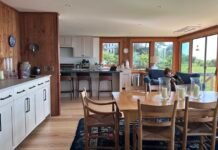Sustainability has become an essential part of modern architectural practices. As climate change and environmental concerns grow, architectural design services have embraced sustainable living to create structures that harmonize with nature while meeting human needs. This shift not only addresses global environmental challenges but also promotes healthier, more cost-effective, and innovative building solutions.
Understanding Sustainability in Architecture
What Is Sustainable Living in Architecture?
Sustainable living in architecture focuses on designing and constructing buildings that minimize environmental impact. This approach ensures that resources such as energy, water, and materials are used efficiently while reducing waste and pollution. At its core, sustainability in architecture aims to balance environmental responsibility, economic feasibility, and social well-being.
Principles of Sustainable Architectural Design
Sustainable architectural design integrates several key principles, including:
- Energy Efficiency: Utilizing renewable energy sources like solar panels and designing buildings to optimize natural light and ventilation.
- Eco-Friendly Materials: Incorporating recycled, biodegradable, or locally sourced materials to reduce carbon footprints.
- Water Conservation: Implementing rainwater harvesting systems and water-efficient fixtures.
- Waste Reduction: Reducing construction waste through innovative design and repurposing materials.
The Role of Architects in Promoting Sustainability
Integrating Green Design Strategies
Architects play a pivotal role in embedding sustainable practices into their designs. By leveraging advanced tools like Building Information Modeling (BIM) and energy simulation software, they create structures that maximize efficiency. For instance, passive solar design—orienting a building to make the most of sunlight for heating and cooling—is a key strategy used by modern designers.
Urban Sustainability and Smart Cities
As cities expand, urban sustainability becomes crucial. Architects are adopting green infrastructure techniques such as green roofs, vertical gardens, and permeable pavements. Smart city concepts, which involve the integration of technology to optimize energy use and waste management, are also gaining momentum.
Benefits of Sustainable Architectural Design
Environmental Benefits
Sustainable architecture significantly reduces greenhouse gas emissions and conserves natural resources. For example, buildings designed to use renewable energy can cut carbon emissions by up to 70%, according to studies by the International Energy Agency.
Economic Advantages
While sustainable buildings may require higher upfront investments, they result in long-term savings. Energy-efficient designs reduce utility bills, and green certifications can increase property values by 10% to 25%.
Health and Well-Being
Sustainable buildings often feature improved air quality, natural lighting, and thermal comfort, which enhance occupants’ physical and mental health. Studies have shown that such environments boost productivity and reduce stress.
Challenges in Implementing Sustainable Design
Cost Considerations
One of the biggest hurdles is the initial cost. Green materials and technologies can be expensive, making it difficult for some clients to adopt them. However, these costs are often offset by long-term savings in energy and maintenance.
Lack of Awareness
Many clients and stakeholders are still unaware of the benefits and possibilities of sustainable design. Education and advocacy are crucial in bridging this gap.
Regulatory Barriers
Inconsistent regulations and building codes across regions can complicate the implementation of sustainable practices. Architects must navigate these complexities to deliver effective solutions.
Innovations Driving Sustainable Architecture
Renewable Energy Integration
Architects are increasingly integrating renewable energy solutions like solar panels, wind turbines, and geothermal systems into their designs. For example, net-zero energy buildings—structures that produce as much energy as they consume—are becoming more common.
Biophilic Design
This approach incorporates natural elements into architectural design, such as green walls, indoor plants, and water features. Biophilic design not only enhances sustainability but also improves mental well-being and productivity.
Smart Technologies
Smart technologies, such as automated lighting and energy management systems, help optimize resource use. These innovations enable real-time monitoring and adjustments, ensuring efficiency and reducing waste.
Case Studies: Success Stories in Sustainable Design
The Bullitt Center, Seattle
Known as the “greenest commercial building in the world,” the Bullitt Center features solar panels, composting toilets, and a rainwater harvesting system. It operates as a net-zero energy building, setting a benchmark for sustainable design.
Bosco Verticale, Milan
This residential project incorporates vertical forests—two towers adorned with over 900 trees and 20,000 plants. Bosco Verticale improves air quality, reduces urban heat, and creates a unique aesthetic.
BedZED, London
The Beddington Zero Energy Development (BedZED) is the UK’s largest sustainable community. It uses renewable energy, recycled materials, and water-saving technologies, serving as a model for future developments.
The Future of Architectural Design Services in Sustainability
The demand for sustainable architectural solutions is expected to grow as environmental concerns intensify. Architects will increasingly collaborate with engineers, urban planners, and policymakers to create holistic solutions that address both individual and community needs. Innovations in materials science, artificial intelligence, and renewable energy will further revolutionize the field.
Architectural design services have a vital role in advancing sustainable living, transforming the way we build and inhabit spaces. If you’re seeking innovative, sustainable design solutions, consider partnering with Hellbent Design Studio. Their expertise in blending architectural creativity with environmental consciousness makes them the ideal choice for your next project.












